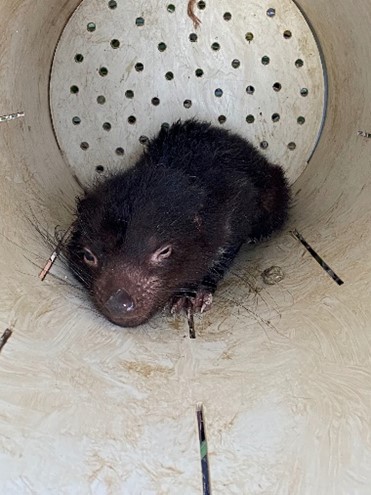by Dr Elspeth McLennan (Post-doc)
Tasmanian devils are nocturnal. We set traps during the day and overnight curious devils will come to investigate. The traps we use are made of strong PVC plastic fashioned into a cylinder with a spring trap door (see cover picture). The traps are baited with a devil’s favourite treat, a piece of fresh lamb or wallaby. The meat is tied onto the end of a string, fed through the trap, and tied to a pin which holds the door open.

When a devil comes investigating the smell of the meat, they walk to the end of the trap and take the bait. When the meat is pulled and eaten, the pin holding the door open is pulled free and the door swings shut. A second pin slides forward as the door closes and locks it. Devils spend the night in a cosy enclosed space with a full belly. The field biologists begin checking the traps as soon as the sun is up. As its daylight, we often find devils snoozing in their traps.
To perform a health check on the devil, we place a hessian sack over the opening of the trap, gently tilt the trap and the devil slides forward into the sack. The sack is used to keep the devil’s eyes covered to keep them calm making them easier to handle while we check them over. We take their weight, check their body condition, look for wounds and record pouch young in females. For populations suffering from devil facial tumour disease (DFTD), the disease status of each animal is also recorded. Once the devil has been processed, they are released. On a single trapping trip, we will often see the same devils a few times. The free food and somewhere to crash is clearly a good draw.
Author

Dr Elspeth McLennan (Post-doc) is working the on the Koala Genome Survey, investigating both neutral and functional diversity across the koala’s range to better understand the impacts of a changing climate. Elspeth has expertise in conservation genetics and using translocation and assisted colonisations as a conservation management tool.
